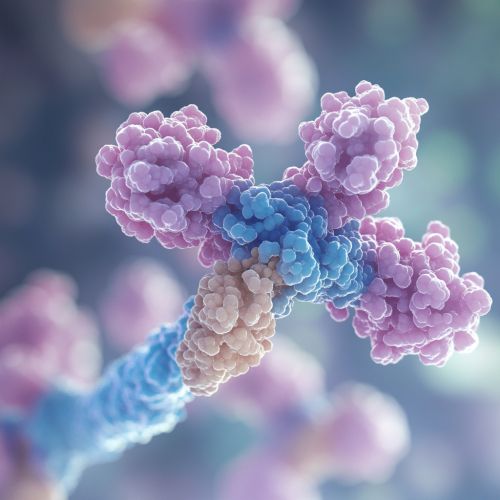Human leukocyte antigen
Introduction
The human leukocyte antigen (HLA) system is a complex set of genes located on chromosome 6 in humans. These genes encode cell-surface antigen-presenting proteins that are essential for the immune system to recognize foreign molecules. The HLA system plays a critical role in the regulation of the immune response, particularly in the context of organ transplantation, autoimmune diseases, and susceptibility to infections.
Structure and Function
Genetic Organization
The HLA genes are part of the major histocompatibility complex (MHC) and are divided into three classes: Class I, Class II, and Class III. Each class has distinct functions and molecular structures.
- **Class I HLA Genes**: These include HLA-A, HLA-B, and HLA-C. They encode glycoproteins that present endogenous peptides to cytotoxic T lymphocytes (CTLs). Class I molecules are expressed on almost all nucleated cells.
- **Class II HLA Genes**: These include HLA-DP, HLA-DQ, and HLA-DR. They encode proteins that present exogenous peptides to helper T lymphocytes (Th cells). Class II molecules are primarily expressed on antigen-presenting cells such as dendritic cells, macrophages, and B lymphocytes.
- **Class III HLA Genes**: These genes encode various proteins involved in the immune response, including components of the complement system and cytokines.
Molecular Structure
HLA molecules are heterodimeric proteins composed of an alpha chain and a beta-2 microglobulin (for Class I) or an alpha and beta chain (for Class II). The peptide-binding groove of HLA molecules is highly polymorphic, allowing for the presentation of a diverse array of peptides to T cells.


Role in Immune Response
HLA molecules are pivotal in the immune system's ability to distinguish self from non-self. They present peptide fragments derived from pathogens or altered self-proteins to T cells, initiating an immune response.
- **Antigen Presentation**: Class I HLA molecules present peptides from intracellular pathogens (e.g., viruses) to CD8+ T cells, leading to the destruction of infected cells. Class II HLA molecules present peptides from extracellular pathogens to CD4+ T cells, which help activate other immune cells.
- **T Cell Activation**: The interaction between HLA-peptide complexes and T cell receptors (TCRs) is crucial for T cell activation and subsequent immune responses.
- **Immune Tolerance**: HLA molecules also play a role in maintaining immune tolerance by presenting self-peptides, which helps prevent autoimmune reactions.
Clinical Significance
Organ Transplantation
The HLA system is a key factor in the success of organ and tissue transplantation. HLA matching between donor and recipient reduces the risk of graft rejection and improves transplant outcomes. The degree of HLA compatibility is assessed through HLA typing, which identifies specific HLA alleles in both donor and recipient.
Autoimmune Diseases
Certain HLA alleles are associated with an increased risk of developing autoimmune diseases. For example, HLA-B27 is strongly linked to ankylosing spondylitis, while HLA-DR4 is associated with rheumatoid arthritis. The mechanisms by which HLA alleles contribute to autoimmunity involve aberrant antigen presentation and T cell activation.
Infectious Diseases
HLA polymorphisms can influence susceptibility to infectious diseases. For instance, specific HLA alleles have been linked to resistance or susceptibility to HIV infection and progression. The diversity of HLA molecules in a population can affect the overall immune response to emerging pathogens.
HLA Typing and Testing
HLA typing is performed using various techniques, including serological methods, polymerase chain reaction (PCR)-based assays, and next-generation sequencing (NGS). Accurate HLA typing is essential for organ transplantation, disease association studies, and understanding population genetics.
- **Serological Methods**: These involve the use of antibodies to detect specific HLA antigens on the surface of cells.
- **PCR-Based Assays**: These methods amplify specific HLA gene regions to identify alleles.
- **Next-Generation Sequencing**: NGS provides high-resolution typing by sequencing the entire HLA gene region, allowing for the identification of novel alleles and detailed allele frequencies.
Evolution and Diversity
The HLA system exhibits extensive genetic diversity, which is thought to be driven by evolutionary pressures such as pathogen-mediated selection. The high degree of polymorphism in HLA genes allows populations to respond to a wide range of pathogens, contributing to immune system adaptability.
- **Balancing Selection**: This form of natural selection maintains multiple alleles at high frequencies within a population, enhancing the ability to present diverse antigens.
- **Heterozygote Advantage**: Individuals with heterozygous HLA genotypes may have a survival advantage due to their ability to present a broader array of peptides.
HLA and Disease Association Studies
HLA association studies have identified numerous links between specific HLA alleles and various diseases. These studies involve comparing the frequency of HLA alleles in affected individuals versus healthy controls to identify potential genetic risk factors.
- **Genome-Wide Association Studies (GWAS)**: These studies analyze the entire genome to identify genetic variants associated with diseases, including those within the HLA region.
- **Case-Control Studies**: These studies compare the HLA allele frequencies between cases (disease-affected individuals) and controls (healthy individuals).
Future Directions
Research on the HLA system continues to evolve, with ongoing studies aimed at understanding the molecular mechanisms underlying HLA-associated diseases, improving HLA typing technologies, and exploring the role of HLA diversity in population health.
- **Immunotherapy**: Advances in immunotherapy, including CAR-T cell therapy and checkpoint inhibitors, are influenced by HLA interactions and may benefit from personalized HLA typing.
- **Personalized Medicine**: HLA typing is becoming increasingly important in personalized medicine, where treatment strategies are tailored based on an individual's genetic makeup, including their HLA profile.
- **Population Genetics**: Studies on HLA diversity contribute to our understanding of human evolution, migration patterns, and population health.
